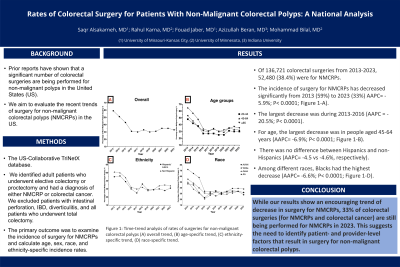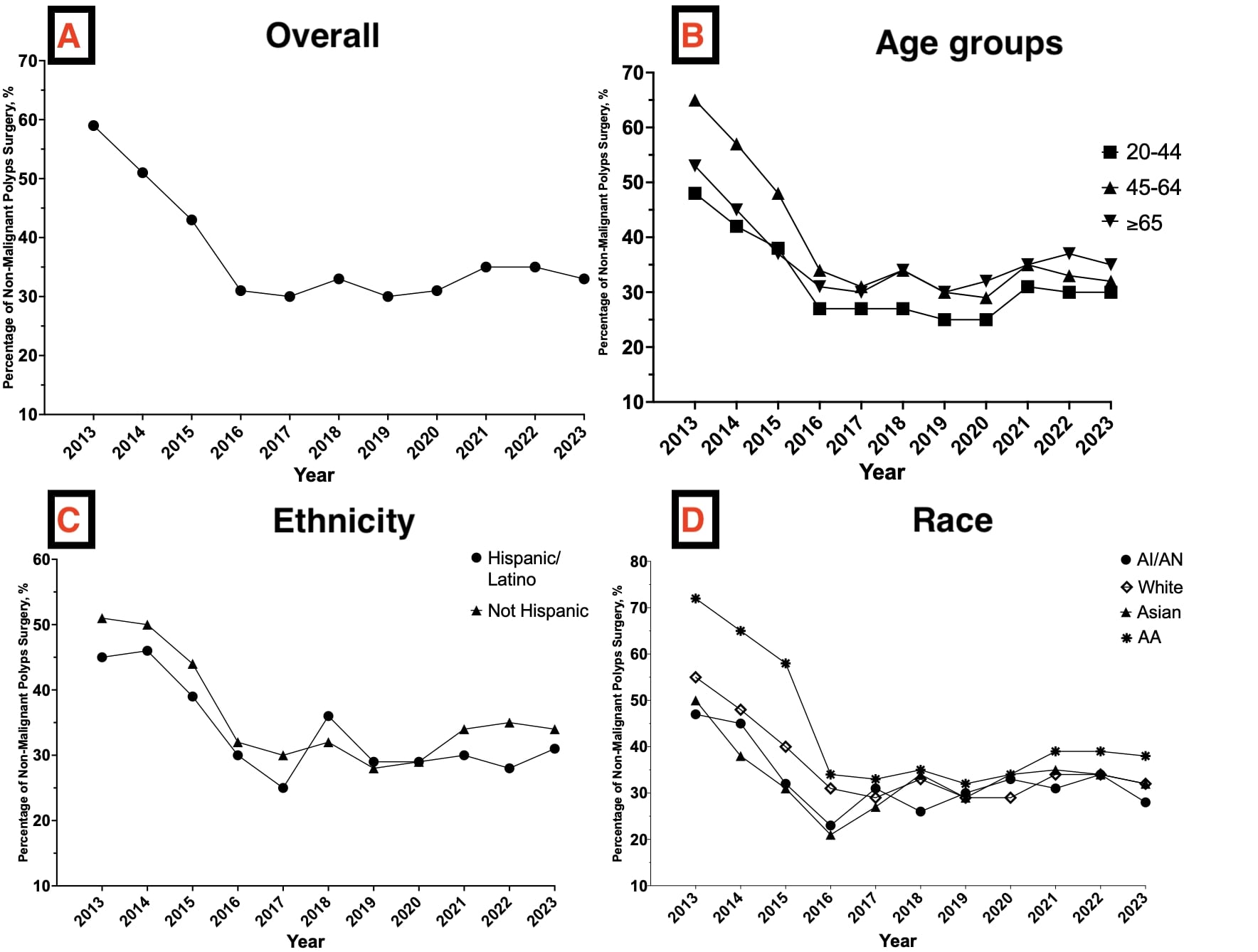Monday Poster Session
Category: Colon
P1948 - Rates of Colorectal Surgery for Patients With Non-Malignant Colorectal Polyps: A National Analysis
Monday, October 28, 2024
10:30 AM - 4:00 PM ET
Location: Exhibit Hall E

Has Audio
.jpg)
Saqr Alsakarneh, MD
University of Missouri - Kansas City School of Medicine
Kansas City, MO
Presenting Author(s)
Saqr Alsakarneh, MD1, Rahul Karna, MD2, Fouad Jaber, MD1, Azizullah Beran, MD3, Mohammad Bilal, MD4
1University of Missouri - Kansas City School of Medicine, Kansas City, MO; 2University of Minnesota Medical Center, Minneapolis, MN; 3Indiana University School of Medicine, Indianapolis, IN; 4University of Minnesota and Minneapolis VA Health Care System, Minneapolis, MN
Introduction: Prior reports have shown that a significant number of colorectal surgeries are being performed for non-malignant polyps in the United States (US). However, since then, there has been increasing education and consensus guidance suggesting that advanced endoscopist resection techniques are safe and effective for the management of large, non-malignant polyps. We aim to evaluate the recent trends of surgery for non-malignant colorectal polyps (NMCRPs) in the US.
Methods: We queried clinical data from TriNetX, a large national database that aggregates healthcare data from 64 healthcare organizations in the US, comprising over 111 million patients. TriNetX uses ICD-10 codes as well as CPT codes to identify diagnoses and procedures. We identified adult patients who underwent elective colectomy or proctectomy and had a diagnosis of either NMCRP or colorectal cancer. We excluded patients with intestinal perforation, IBD, diverticulitis, and all patients who underwent total colectomy. The primary outcome was to examine the incidence of surgery for NMCRPs and calculate age, sex, race, and ethnicity-specific incidence rates of surgery for non-malignant colorectal polyps. Secondary outcomes included the incidence trend over the last decade and the rates of and postoperative adverse events between non-malignant and malignant colorectal polyps.
Results: Of 136,721 colorectal surgeries from 2013-2023, 52,480 (38.4%) were for NMCRPs. The incidence of surgery for NMCRPs has decreased significantly from 2013 (59%) to 2023 (33%) (average annual percentage change (AAPC) = -5.9%; P< 0.0001; Figure 1-A). The largest decrease was during 2013-2016 (AAPC = -20.5%; P< 0.0001). For age, the largest decrease was in people aged 45-64 years (AAPC= -6.9%; P< 0.0001; Figure 1-B). There was no difference between Hispanics and non-Hispanics (AAPC= -4.5 vs -4.6%, respectively). Among different races, Blacks had the highest decrease (AAPC= -6.6%; P< 0.0001; Figure 1-D). Postoperative wound, infectious, urinary, pulmonary, gastrointestinal, or cardiovascular adverse events were significantly higher in patients with malignant polyps (Table 1).
Discussion: While our results show an encouraging trend of decrease in surgery for NMCRPs, 33% of colorectal surgeries (for NMCRPs and colorectal cancer) are still being performed for NMCRPs in 2023. This suggests the need to identify patient- and provider-level factors that result in surgery for non-malignant colorectal polyps.

Note: The table for this abstract can be viewed in the ePoster Gallery section of the ACG 2024 ePoster Site or in The American Journal of Gastroenterology's abstract supplement issue, both of which will be available starting October 27, 2024.
Disclosures:
Saqr Alsakarneh, MD1, Rahul Karna, MD2, Fouad Jaber, MD1, Azizullah Beran, MD3, Mohammad Bilal, MD4. P1948 - Rates of Colorectal Surgery for Patients With Non-Malignant Colorectal Polyps: A National Analysis, ACG 2024 Annual Scientific Meeting Abstracts. Philadelphia, PA: American College of Gastroenterology.
1University of Missouri - Kansas City School of Medicine, Kansas City, MO; 2University of Minnesota Medical Center, Minneapolis, MN; 3Indiana University School of Medicine, Indianapolis, IN; 4University of Minnesota and Minneapolis VA Health Care System, Minneapolis, MN
Introduction: Prior reports have shown that a significant number of colorectal surgeries are being performed for non-malignant polyps in the United States (US). However, since then, there has been increasing education and consensus guidance suggesting that advanced endoscopist resection techniques are safe and effective for the management of large, non-malignant polyps. We aim to evaluate the recent trends of surgery for non-malignant colorectal polyps (NMCRPs) in the US.
Methods: We queried clinical data from TriNetX, a large national database that aggregates healthcare data from 64 healthcare organizations in the US, comprising over 111 million patients. TriNetX uses ICD-10 codes as well as CPT codes to identify diagnoses and procedures. We identified adult patients who underwent elective colectomy or proctectomy and had a diagnosis of either NMCRP or colorectal cancer. We excluded patients with intestinal perforation, IBD, diverticulitis, and all patients who underwent total colectomy. The primary outcome was to examine the incidence of surgery for NMCRPs and calculate age, sex, race, and ethnicity-specific incidence rates of surgery for non-malignant colorectal polyps. Secondary outcomes included the incidence trend over the last decade and the rates of and postoperative adverse events between non-malignant and malignant colorectal polyps.
Results: Of 136,721 colorectal surgeries from 2013-2023, 52,480 (38.4%) were for NMCRPs. The incidence of surgery for NMCRPs has decreased significantly from 2013 (59%) to 2023 (33%) (average annual percentage change (AAPC) = -5.9%; P< 0.0001; Figure 1-A). The largest decrease was during 2013-2016 (AAPC = -20.5%; P< 0.0001). For age, the largest decrease was in people aged 45-64 years (AAPC= -6.9%; P< 0.0001; Figure 1-B). There was no difference between Hispanics and non-Hispanics (AAPC= -4.5 vs -4.6%, respectively). Among different races, Blacks had the highest decrease (AAPC= -6.6%; P< 0.0001; Figure 1-D). Postoperative wound, infectious, urinary, pulmonary, gastrointestinal, or cardiovascular adverse events were significantly higher in patients with malignant polyps (Table 1).
Discussion: While our results show an encouraging trend of decrease in surgery for NMCRPs, 33% of colorectal surgeries (for NMCRPs and colorectal cancer) are still being performed for NMCRPs in 2023. This suggests the need to identify patient- and provider-level factors that result in surgery for non-malignant colorectal polyps.

Figure: Figure 1: Time-trend analysis of rates of surgeries for non-malignant colorectal polyps (A) overall trend, (B) age-specific trend, (C) ethnicity-specific trend, (D) race-specific trend.
Note: The table for this abstract can be viewed in the ePoster Gallery section of the ACG 2024 ePoster Site or in The American Journal of Gastroenterology's abstract supplement issue, both of which will be available starting October 27, 2024.
Disclosures:
Saqr Alsakarneh indicated no relevant financial relationships.
Rahul Karna indicated no relevant financial relationships.
Fouad Jaber indicated no relevant financial relationships.
Azizullah Beran indicated no relevant financial relationships.
Mohammad Bilal: Boston Scientific – Consultant. Cook endoscopy – Speakers Bureau.
Saqr Alsakarneh, MD1, Rahul Karna, MD2, Fouad Jaber, MD1, Azizullah Beran, MD3, Mohammad Bilal, MD4. P1948 - Rates of Colorectal Surgery for Patients With Non-Malignant Colorectal Polyps: A National Analysis, ACG 2024 Annual Scientific Meeting Abstracts. Philadelphia, PA: American College of Gastroenterology.
